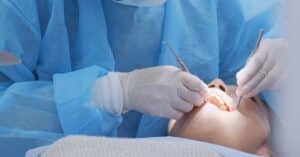Regular dental check-ups are essential to maintaining your smile and overall health. Routine dental cleanings may be enough to remove the buildup of plaque and tartar, which could cause cavities and more serious problems if ignored.
Tartar accumulation can cause gum disease. A dentist will likely recommend a deep dental cleaning when gum disease becomes severe. Here is what you need to know about what deep cleaning is, when it is necessary, and how it can benefit your oral health.
What Is Dental Deep Cleaning?

When severe gum disease or periodontitis develops, routine professional cleaning will not be enough to remove the tartar and restore gum health. The dentist usually recommends deep cleaning to reverse gum disease, guard against infection, and prevent tooth loss.
What Is Involved in Dental Deep Cleaning?
If you think you might benefit from a dental deep cleaning, your dentist can determine whether you have gum disease and need this procedure. First, the dentist will measure the gap between your gums and teeth with a periodontal probe. A gap greater than 3 mm typically signals gum disease. Your dentist will also probably order x-rays of your teeth to identify any tooth damage and determine whether a deep cleaning might make it worse.
Bleeding gums, inflammation, and loose teeth also signal gum disease. While most dentists do not treat gingivitis with deep cleaning, periodontitis and more advanced stages of gum disease usually require it.
After the diagnosis, you will schedule two deep cleaning appointments. Because you will typically need a local anesthetic for this procedure, the dentist will only do one side of your mouth during each visit. Otherwise, numbing your whole mouth would make it difficult to eat, drink, or speak afterward.
At the start of each appointment, the dentist will apply a numbing cream or inject an anesthetic into your gums, making the deep cleaning painless. Then, they will use a scraping instrument and a vibrating ultrasonic device to remove the tartar and plaque.
When you come in for your second appointment, the dentist will use the same instruments to remove the plaque and tartar from the other side of your mouth. They will also check the areas they treated during your last visit to ensure proper recovery.
Each appointment will last 1-4 hours. If you have a severe infection, the dentist may add an antibiotic gel to the tooth-gum gaps. You may also need mouthwash or antibiotic tablets to continue treating the infection.
Post-Procedure Care
For 24 hours after each appointment, avoid brushing and flossing. You should expect minor gum soreness and tooth sensitivity for about a week. When you are ready to brush and floss again, use toothpaste for sensitive teeth and a toothbrush with soft bristles. During this week of recovery, you should also avoid icy and hot food and beverages, which could aggravate your tooth sensitivity.
Your dentist will ask you to schedule a follow-up (comprehensive periodontal exam) visit about six weeks after your last deep cleaning. During this follow-up, your dentist will check your recovery and take another measurement of the gaps between your teeth and gums. Your dentist will refer you to a specialist if you need more aggressive treatment.
If you maintain proper oral hygiene after your appointments and follow-up, you may not need more deep cleanings. You should continue your daily brushing and flossing and regular dental check-ups to prevent gum disease from reoccurring.
Benefits of Teeth Deep Cleaning
Deep dental cleaning can be effective in stopping or slowing down gum disease. It can also thwart tooth loss and help with bleeding gums. Deep cleaning can prevent gum disease from causing more severe complications that may require surgical procedures like tissue grafts and flap surgery.
Drawbacks of Teeth and Deep Gum Cleaning
When considering deep dental cleaning, it is also important to learn about the potential disadvantages and risks, such as soreness, sensitivity, and bleeding of the gums. However, this discomfort is typical and will disappear after about a week and in some rare cases may take 2-3 weeks.
Also, the procedure can be uncomfortable and seem scary to patients afraid of the dentist. Because patients get a local anesthetic, they will not feel any pain.
For some patients, the cost of the procedure can be another drawback. Out-of-pocket expenses can vary between $150-$350 per quadrant of the mouth. This amount usually does not include the cost of anesthesia. Many dentist offices offer payment plans for individuals who do not have dental insurance.
Some patients worry about tooth loss after deep cleaning. Your teeth might initially feel a little loose after the procedure, which is temporary. Over time, the gaps between the teeth and gums will decrease, giving you a more secure feeling. If your dentist thinks deep cleaning could lead to tooth loss, they will recommend another treatment.
- Dental Implant Pros and Cons - August 26, 2023
- Receding Gums Stages - August 12, 2023
- When Is It Too Late for Gum Grafting? - July 8, 2023


